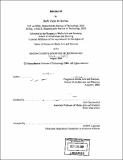Internet 0
Author(s)
Krikorian, Raffi Chant, 1978-
DownloadFull printable version (5.383Mb)
Alternative title
Internet zero
Other Contributors
Massachusetts Institute of Technology. Dept. of Architecture. Program in Media Arts and Sciences.
Advisor
Neil Gershenfeld.
Terms of use
Metadata
Show full item recordAbstract
The Internet is currently unsuitable for small devices because the assumptions behind its architecture for desktop and server computers do not scale down. Implementations and costs that apply to larger machines have a baseline that is still too high for small embedded objects that cost only a few dollars, thereby leaving many devices disenfranchised and in disconnected groups. Similar to computer network evolution where the Internet was used to bridge together heterogeneous computer systems, I present Internet 0 (I0) as a framework to bridge together heterogeneous devices via Internet Protocols--therefore in a manner that is compatible with designing globally large computer networks. I examine the seven following themes of Internet 0. No one of these themes are new, however it is unique to have them all present in one system: 1. bringing the Internet Protocol all the way to the device level to make devices full network citizens; 2. compiling standards and delayering network protocol stacks to make them computationally efficient enough to fit into embedded microprocessors; 3. allowing devices to talk to each other directly to remove the necessity of centralized servers and protocol converters; 4. advertising a device not only to the network world but also to the physical one to allow direct interactions between objects and objects and also objects and people; 5. slowing down networks to decrease network complexity and therefore simplify network access; 6. using the same modulation scheme across many different media so device designers can be free to choose their preferred hardware medium but not be isolated from devices that use another; and 7. pushing the engineering politics of open standards to inspire competition not in differing architectures, but (cont.) in differing network services. During this examination, I contrast these themes with the current methodologies used for device networking and propose new I0 based architectures that can replace the original solutions.
Description
Thesis (S.M.)--Massachusetts Institute of Technology, School of Architecture and Planning, Program in Media Arts and Sciences, 2004. Includes bibliographical references (p. 81-84).
Date issued
2004Department
Program in Media Arts and Sciences (Massachusetts Institute of Technology)Publisher
Massachusetts Institute of Technology
Keywords
Architecture. Program in Media Arts and Sciences.